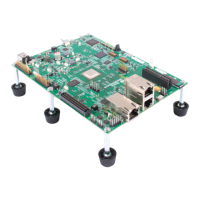An Overview of Real-Time Analysis
3-2
3.1 An Overview of Real-Time Analysis
Real-time analysis is the analysis of data acquired during real-time operation
of a system. The intent is to easily determine whether the system is operating
within its design constraints, is meeting its performance targets, and has
room for further development.
Note:
RTDX is occasionally not supported for the initial releases of a new DSP
device or board. On platforms where RTDX is not supported, the RTA tools
in CCSv4 are non-functional.
3.1.1 Real-Time Versus Cyclic Debugging
The traditional debugging method for sequential software is to execute the
program until an error occurs. You then stop the execution, examine the
program state, insert breakpoints, and reexecute the program to collect
information. This kind of cyclic debugging is effective for non-real-time
sequential software. However, cyclic debugging is rarely as effective in real-
time systems because real-time systems are characterized by continuous
operation, nondeterministic execution, and stringent timing constraints.
The DSP/BIOS instrumentation APIs and the DSP/BIOS Analysis Tools are
designed to complement cyclic debugging tools to enable you to monitor real-
time systems as they run. This real-time monitoring data lets you view the
real-time system operation so that you can effectively debug and
performance-tune the system.
3.1.2 Software Versus Hardware Instrumentation
Software monitoring consists of instrumentation code that is part of the target
application. This code is executed at run time, and data about the events of
interest is stored in the target system’s memory. Thus, the instrumentation
code uses both the computing power and memory of the target system.
The advantage of software instrumentation is that it is flexible and that no
additional hardware is required. Unfortunately, because the instrumentation
is part of the target application, performance and program behavior can be
affected. Without using a hardware monitor, you face the problem of finding
a balance between program perturbation and recording sufficient information.
Limited instrumentation provides inadequate detail, but excessive
instrumentation perturbs the measured system to an unacceptable degree.
DSP/BIOS provides several mechanisms that allow you to control precisely
the balance between intrusion and information gathered. In addition, the
DSP/BIOS instrumentation operations all have fixed, short execution times.
Since the overhead time is fixed, the effects of instrumentation are known in
advance and can be factored out of measurements.

